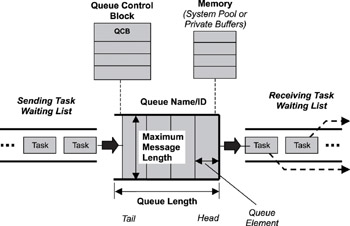Книга: Real-Time Concepts for Embedded Systems
7.2 Defining Message Queues
7.2 Defining Message Queues
A message queue is a buffer-like object through which tasks and ISRs send and receive messages to communicate and synchornize with data. A message queue is like a pipeline. It temporarily holds messages from a sender until the intended receiver is ready to read them. This temporary buffering decouples a sending and receiving task; that is, it frees the tasks from having to send and receive messages simultaneously.
As with semaphore introduced in Chapter 6, a message queue has several associated components that the kernel uses to manage the queue. When a message queue is first created, it is assigned an associated queue control block (QCB), a message queue name, a unique ID, memory buffers, a queue length, a maximum message length, and one or more task-waiting lists, as illustrated in Figure 7.1.

Figure 7.1: A message queue, its associated parameters, and supporting data structures.
It is the kernel’s job to assign a unique ID to a message queue and to create its QCB and task-waiting list. The kernel also takes developer-supplied parameters-such as the length of the queue and the maximum message length-to determine how much memory is required for the message queue. After the kernel has this information, it allocates memory for the message queue from either a pool of system memory or some private memory space.
The message queue itself consists of a number of elements, each of which can hold a single message. The elements holding the first and last messages are called the head and tail respectively. Some elements of the queue may be empty (not containing a message). The total number of elements (empty or not) in the queue is the total length of the queue. The developer specified the queue length when the queue was created.
As Figure 7.1 shows, a message queue has two associated task-waiting lists. The receiving task-waiting list consists of tasks that wait on the queue when it is empty. The sending list consists of tasks that wait on the queue when it is full. Empty and full message-queue states, as well as other key concepts, are discussed in more detail next.
- Chapter 7: Message Queues
- 4.3 Defining an RTOS
- 8.4.2. Sending and Receiving Messages
- Session Message Block Printing
- Setting Message Delivery Intervals
- 5.1.4. Boot Messages
- 9.9.7 CAN Message Transmission
- 9.9.8 CAN Message Reception
- 8.4.3. The Network Message Server
- 9.4.1.Messages
- The Internet Control Message Protocol
- Send Messages to NetWare Users




